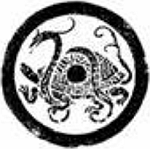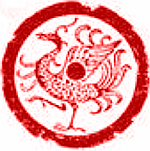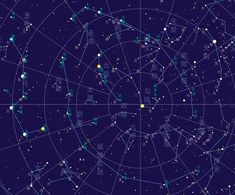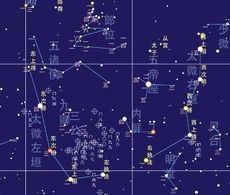
|
|
Lunar StationsChinaOverview |
|


The Chinese Sky |
In ancient Chinese astronomy, the region along the ecliptic was divided into Four Directions.
 Each direction was represented by a mythological creature, the Azure Dragon of the East, the Black Tortoise of the North, the White Tiger of the West and the Vermilion Bird of the South.  A fifth legendary beast, the Yellow Dragon of the Center represented the center of the universe in Chinese mythology.  In addition to a cardinal direction, each creature also represents one of the seasons and one of the Phases or elements.  |
 Han-dynasty pottery depicting the five directions Source: Wikipedia |
 Four Quadrants of Chinese astronomy Source: ecumenicalbuddhism.blogspot.com
|

|
 The five Chinese Elements; © shaungsimpson |

Each quadrant was then further divided into seven Lunar Mansions, corresponding to the longitudes
along the ecliptic that the Moon crosses during its 27.32-day journey around the Earth.
 In addition to the four quadrants of the ecliptic, the circumpolar stars (visible throughout the year) were divided into Three Enclosures, the the northernmost one being the Purple Forbidden Enclosure, followed by the Supreme Palace Enclosure and the Heavenly Market Enclosure.  The Twenty Eight Lunar Mansions and the Three Enclosures were further divided into a total of 283 asterisms, each one consisting on average of a handful of stars. China Saga shows a map (right) lining out both the Greek and the Chinese constellations.  Ian Ridpath points out that these formations "...did not depict myths but facets of Chinese imperial, social, and rural life." |
 Overlap of Greek and Chinese constellations Source: China Saga |


The Four Directions |
  |
  |
  |
 
|

The Three Enclosures |
  |
  |
 
|
|
Source: Ancient China Astronomy
|


|
China Saga shows a map lining out both the Greek and the Chinese constellations. (Right, click on it for a larger image). On her "Chinese Constellations" website, Marilyn Shea provides four beautiful drawings of the sacred animals of the four directions, with the constellations superimposed onto them. (Below, click on the pictures for larger images). |

|


  |
  |
  |
 
|
|
Source: Chinese Constellations
|


|
|
Links to Chinese Astronomy |

Wikipedia - Chinese Astronomy Wikipedia - Chinese Constellations |
Ian Ridpath - Charting the Chinese sky F. Richard Stephenson - Chinese and Korean Star Maps and Catalogs |


Chinese myths and legends around stars, planets and constellations are as old as Chinese astronomy.
 Click here to continue to the world of Chinese astronomical mythology. https://wellcomecollection.org/works/zqz6uqnt/items http://ecumenicalbuddhism.blogspot.com/2010/02/four-symbols-five-cardinal-directions.html http://en.chinaculture.org/focus/focus/2010spring/2010-01/26/content_367602.htm https://en.wikipedia.org/wiki/Yellow_Dragon https://www.deviantart.com/artisticbalance/art/White-Tiger-of-the-West-390820743 https://www.deviantart.com/artisticbalance/art/Black-Tortoise-of-the-North-389240673 https://www.deviantart.com/artisticbalance/art/Vermilion-Bird-of-the-South-388840716
|


|
Back to Star Lore |

Back to History |
Back to Space Page |
Back to English |
 Back to Start Page |